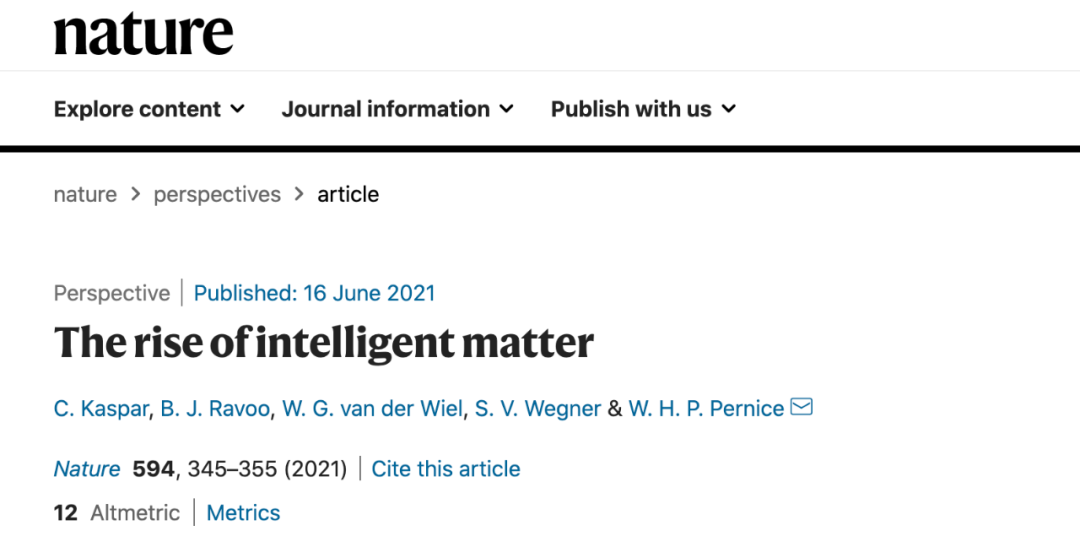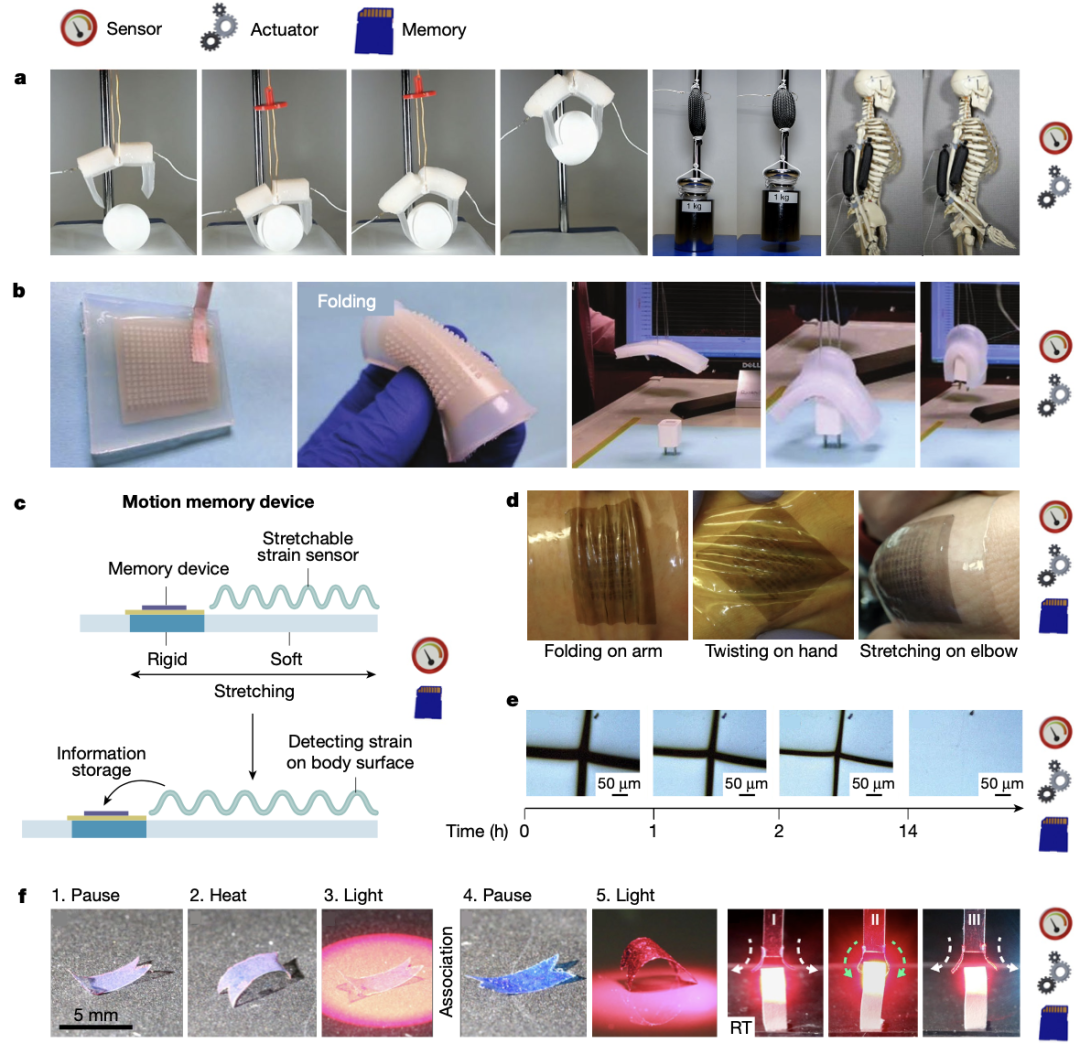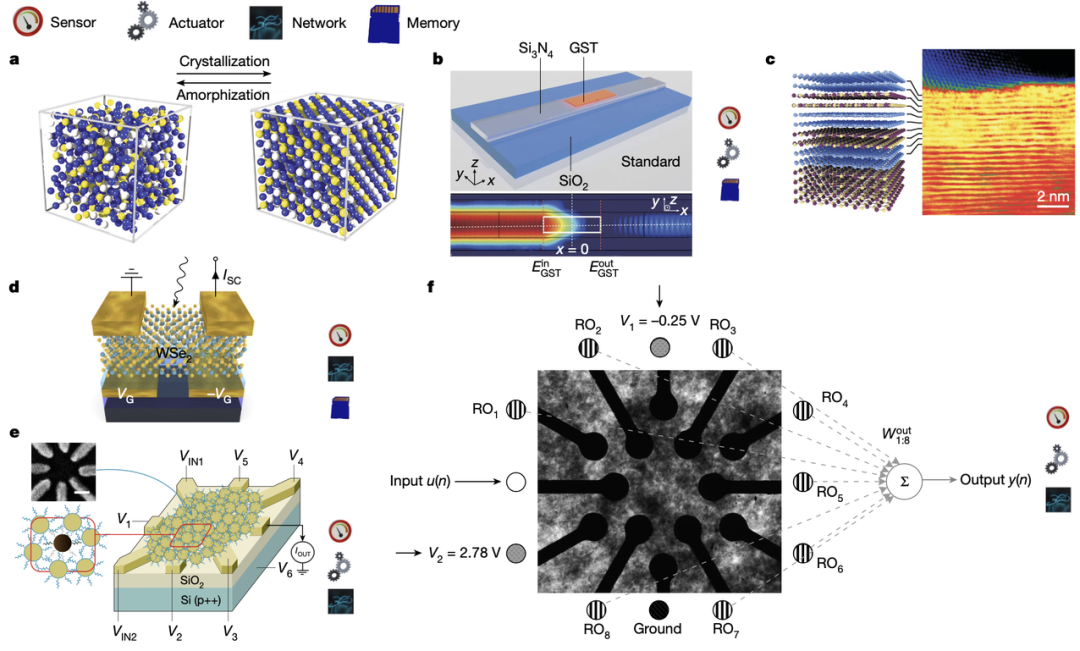Artificial intelligence (AI) is not a new concept anymore. We know that it is inspired by the human brain and neural networks. The human brain is particularly good at computationally intensive cognitive tasks, such as pattern recognition and classification.
Regarding AI, a long-term development goal is decentralized neuromorphic computing, that is, relying on a distributed core network to simulate the large-scale parallel computing of the brain, so as to realize a super information processing method inspired by nature. By gradually transforming interconnected computing blocks into continuous computing organizations, it is possible to conceive advanced material forms with basic characteristics of intelligence. This "smart material" can learn and process information in a non-localized manner, and can receive and Respond to the interaction of external stimuli and the environment, and at the same time can adjust the structure autonomously in order to be able to distribute and store information reasonably. Does this kind of thinking broaden your cognitive boundaries of the word "intelligence" again?
On June 17, a team of scientists from the University of Münster, Germany and the University of Twente, the Netherlands, published an article in the "Nature" magazine to give an overview of "smart substances". They reviewed and analyzed the current industry's use of molecular systems, soft materials or solid-state materials. The progress of intelligent materials realized by materials, as well as the practical applications in soft robots, adaptive artificial skin and distributed neuromorphic computing.
Although the intelligent substances in the thesis do not show the kind of intelligence (such as recognition ability or language ability) that the public is familiar with, their functions have far exceeded the characteristics of static substances, and their potential applications are inspiring.
How to understand smart matter?
Under normal circumstances, we can understand intelligence as the ability to perceive information and use it as a knowledge reserve in order to complete adaptive behavior in a constantly changing environment. Although there is no exact definition of intelligent matter, researchers believe that when it comes to the concept of "intelligence", at least two main characteristics must be included: first, the ability to learn; second, the ability to adapt to the environment. So far, most of these two abilities exist in organisms.
With the popularity of AI technology, people are stepping up efforts to realize the machine learning and adaptation skills in an increasingly complex systems, these systems will be integrated in various functional components together . In addition to these functional architectures, it is worth noting that artificial synthetic substances themselves also show many intelligent characteristics, which may constitute a brand-new concept of AI.
Because advanced AI applications generally need to process a large amount of data, it is very challenging to regulate the behavior of intelligent substances in a centralized manner, especially when using traditional computers based on the von Neumann architecture for centralized information processing. The limit is quickly reached, moving data from the memory to the processor and back, not only greatly reduces the calculation speed, but also requires a lot of power consumption.
Therefore, new methods and computational paradigms need to be implemented directly at the material level, so that smart matter itself can interact with the environment, self-regulate its behavior, and even learn from the input data it accepts.
For the development and design of smart materials, inspiration from nature is very useful. The macroscopic functions of natural substances come from the complex internal structure and the interaction of molecular, nano-scale and macro-scale building blocks. In artificial substances, the combination of bottom-up and top-down methods can make the architecture have various novel characteristics and functions.
Researchers believe that the intelligence of artificial materials can be defined in a hierarchical manner. For example, smart substances are realized by combining four key functional elements: (1) the sensor interacts with the environment and receives input and feedback; (2) the actuator responds to the input signal and adjusts the performance of the material; (3) for long-term use A memory for storing information; (4) A communication network for processing feedback.
Ideally, these elements can form a functional processing continuum, which does not require a centralized processing unit, but provides local and distributed information processing capabilities.
Figure|Structural substances are static and cannot change their properties after synthesis, such as pure silicon; octopus tentacles, with embedded sensors, actuators and nervous system, represent smart substances (source: Nature)
The most basic structural substance, it may contain a highly complex but static structure. Although it has a wide range of applications, its properties cannot be changed after synthesis. At an advanced level, reactive substances can change their characteristics (shape, color, hardness, etc.) in response to external stimuli, such as light, current, or force.
At present, scientists are working hard to explore adaptive substances, which have the inherent ability to deal with internal and external feedback. Therefore, it can respond to different environments and stimuli. This definition is similar to "life-like materials", that is, synthetic materials inspired by living things and living substances.
Researchers believe that transcending adaptive substances will ultimately promote the development of smart substances. Smart substances will include four major functional elements (sensors, actuators, networks, and long-term memory), and can show the highest level of complexity and functionality.
What are the things that tend to be smart?
Researchers outlined in the paper traces the development of smart materials, has given no isozyme example of a complex system level of energy, thereby showing the development of intelligent material may trend.
The first type is cluster-based self-organizing materials (such as nanoparticle assemblies, molecular materials).
A prominent form of complex behavior is to rely on the collective interaction of a group or a large number of individuals in a group. In such a system, multiple individually responding entities will organize and communicate in a special way, thereby realizing large-scale adaptive phenomena and forming a collective protection model. In nature, this behavior is usually observed in insect communities, fish schools, birds and even mammal populations.
When using this concept to implement building blocks on a microscopic scale, this concept of basic intelligence is particularly interesting for the realization of intelligent matter. For example, cluster robots interact with a large group of small robots. Each small robot is about one centimeter high and has limited capabilities, but they can be arranged in complex, predefined shapes.
When considering group behavior on the nanoscale, similar logic is still available, such as nanoparticle assemblies. In self-assembled material systems, the local communication between weakly coupled and highly dynamic components takes place in the form of particle interactions. .
Based on chain formation, repulsive fluid and attractive magnetic interactions between structural nanoparticles, and according to the initial shape, micro-groups can perform reversible anisotropic deformation, controlled splitting and merging with high modal stability, and navigational motions, but these Shape adaptation relies on external programmer input, magnetic field control, etc., so the particles themselves do not show intelligent behavior.
Figure|Adaptive group behavior and colloidal clusters (Source: Nature)
Interesting adaptive behaviors are also found in synthetic molecular systems, and feedback comes from the interaction between the reaction network and coupling molecules. In addition, the transmission of information about the size of self-replicating molecules can be observed. From ancestors to offspring replicons, this behavior is somewhat similar to the norm in biology.
However, the lack of memory in this type of material prevents the material's ability to learn from past events.
The second is the realization of soft matter (such as reactive soft matter, soft matter embedded in memory, and adaptive soft matter).
In biological systems, softness, elasticity, and flexibility are notable features. Molluscs can achieve continuous deformation in a crowded environment, thereby achieving smooth motion. Natural skin also exhibits the remarkable characteristics of basic intelligence, including the tactile sensation of force, pressure, shape, texture and temperature, tactile memory and even self-healing ability.
The goal of the field of soft robotics is to transform these characteristics into soft matter. The soft robot can simulate biological movement by adjusting its shape, grip and touch. Compared with rigid materials, due to the conformity of the materials, when they come into contact with humans or other fragile objects, the risk of injury is greatly reduced.
Figure|Responsive soft matter and soft matter with embedded memory function (Source: Nature)
Soft matter contains reactive soft matter, and the most common drive is the change of shape and softness with input.
A typical example is a self-contained artificial muscle composed of a silicone rubber matrix. Its driving relies on the vapor phase transition when the liquid is embedded in ethanol microbubbles and heated. This sensitive artificial muscle can repeatedly lift more than 6 kilograms of weight.
Another case is based on the double cross-linked responsive hydrogel induced by DNA hybridization. With the help of an external DNA trigger, the volume contraction of the material is locally controlled to imitate human hand gestures. There is also an artificial skin developed by using the triboelectric effect, which can actively sense the proximity, contact, pressure and humidity of the touched object without the need for an external power source, and the skin can autonomously generate an electrical response.
There are also scientists who use the ion gradient between the micro-polyacrylamide hydrogel compartments of the cation and anion selective hydrogel membranes to create an "artificial eel" that uses a retractable stacking or folding geometry to activate thousands at the same time. A voltage of 110 V is generated after a series of gel chambers. Unlike typical batteries, these systems are soft, flexible, transparent and potentially biocompatible.
Soft matter embedded in memory, this type of functional soft matter combines material memory and perception capabilities. Some scientists have verified this concept in a mechanical hybrid material, in which a resistance switching device is used as a storage element on an island of rigid polymer photoresist (SU-8), which is embedded with stretchable polydimethylsiloxane In (PDMS), the microcracks in the gold film evaporated on polydimethylsiloxane act as electrodes and stress sensors at the same time. This kind of motion memory device allows the detection of humans based on changes in stress and subsequent information storage Movement of the limbs.
In addition, self-healing is also an important property of soft materials, allowing materials to quickly restore their original properties after being disturbed/bent, and is a way to eliminate past traumatic memories. A scientific team has reported an organic thin film transistor. This kind of transistor is made of stretchable semiconducting polymer, which can work normally even when folded, twisted and stretched on the moving human limbs, and this kind of polymer can repair itself after special solvent and heat treatment, almost completely The field effect mobility is restored.
Information processing usually involves counting, which requires a perception ability and a storage unit that stores the latest value. A scientific research team has proposed a design concept based on subsequent biochemical reactions to calculate substances, which can release specific light pulses based on the number of detected light pulses. The output molecules or enzymes to achieve the actual counting process.
In addition to sensing and driving, the adaptive soft matter also includes a precisely customized chemical-mechanical feedback loop. One way to realize adaptive soft matter is the autonomous particle motion model system proposed by scientists. It contains an elegant combination of sensing and driving, coupled through a reaction network, for example, there is a material that can regulate the growth and contraction of oxygen bubbles in the capsule. , Which leads to the antagonistic adjustment of effective buoyancy, and realizes the oscillating vertical movement of the colloid in the water driven by the enzyme.
The third type is the realization of solid materials (such as neuromorphic materials, distributed neuromorphic systems).
At present, the information processing technology of solid materials is much more advanced. For example, the traditional computer core is constructed by physical devices (such as chip transistors). Non-traditional computing surpasses standard computing models, especially biology, which can be considered as non-traditional computing systems.
Programmable and highly interconnected networks are particularly suitable for performing computational tasks, while brain-inspired or neuromorphic hardware is designed to provide physical implementation. Although in the top-down manufacturing of the semiconductor industry, mature semiconductor materials are used to enable neuromorphic hardware (such as Google’s tensor processing unit) to be realized, the bottom-up approach using nanomaterials may be unconventional and Efficient calculations provide new ways.
Researchers believe that combining the above-mentioned various material realizations, the hybrid method may eventually lead to the realization of smart materials.
For example, the use of phase change materials to simulate neuromorphic computing systems has become a key enabling factor for brain-inspired or neuromorphic hardware, allowing artificial neurons and synapses to be implemented in artificial neural networks, using them to be heated in an amorphous or crystalline state by Joule heating Under the programmability to achieve fast, accessible room temperature non-volatile memory function.
The memory behavior of phase change materials further makes them suitable for brain-inspired calculations, where they usually embody synaptic weights or nonlinear activation functions. In addition, two-dimensional (2D) materials, such as graphene , molybdenum disulfide, tungsten diselenide, or hexagonal boron nitride, have also appeared in experiments with neuromorphic devices, allowing the design of compact artificial neural networks.
A recent study showed that it is possible to perform nonlinear classification and feature extraction on disordered networks of boron-doped atoms in silicon at a temperature of 77K. Many other research results show that the deep neural network model of nanoelectronic devices can be used to effectively adjust the device through the gradient descent method to complete various classification tasks instead of achieving functions through artificial evolution.
These works reveal the potential for efficient calculations at the nanometer scale using the inherent physical properties of matter.
Figure|Neuromorphic materials and systems (Source: Nature)
It is worth noting that in the neuromorphic system, information processing and memory are co-localized, which is strictly different from the traditional von Neumann structure. One promising study is the optical neural network model, because light itself can be calculated by interacting with matter or interfering with itself without pre-defined paths. In addition, this model allows data to be processed at the speed of light (in the medium). Processing, and the power consumption is extremely low compared with electronic equipment.
When light propagates through different diffractive layers, the information is processed at the same time, similar to the preprocessing of data in human skin before it is transmitted to the brain through the nervous system.
In addition, the researchers also believe that each material reservoir has its own physical problems, and material learning can be used to make the reservoir emerge from the system instead of designing the material matrix into a good reservoir.
Looking forward to the future development path
So, what are the challenges in the future?
Researchers believe that the difficulty lies in the development of effective methods for manufacturing, amplifying and controlling smart substances.
Smart substances must contain dynamic materials with considerable degrees of confocal freedom, mobility, and nano-level component exchange. This means that the interaction between nanoscale components must be weak enough to be manipulated by external stimuli. In addition, such substances must exhibit a certain degree of internal organization of nano-level components, so that feedback and long-term memory elements can be embedded, and in order to fully receive and transmit external input, addressability with spatial and temporal accuracy is required. These requirements may be contradictory to a large extent, and may not be compatible.
Obviously, the key elements of smart materials are easier to implement in different material types, but researchers hope that hybrid solutions can solve the incompatibility problem.
So, what will the road map to smart matter look like? They have an idea.
First, a demonstrator and design rules are needed to develop an adaptive substance with an inherent feedback path. By integrating nano-scale building blocks, the self-assembly and top-down manufacturing of nanostructures can be reconfigurable and adaptable;
Then, it must start with adaptive substances that can handle feedback and develop into substances with learning capabilities ("learning substances"). These materials will be enhanced by embedded memory functions, material-based learning algorithms and sensor interfaces;
In addition, it is also necessary to develop from learning materials to truly intelligent materials, receive input from the environment through sensory interfaces, display the required response through embedded memory and artificial networks, and respond to external stimuli through embedded sensors.
Therefore, the development of smart materials will require coordinated, interdisciplinary and long-term research efforts.
Ultimately, considering that overall performance is the collective response of components and connections, a complete system-level demonstration is necessary to accelerate the use of smart materials. Various technological applications of smart materials are foreseeable, and the collaborative integration with existing AI and neuromorphic hardware will be particularly attractive. In this regard, applications in life sciences and biological cybernetic organisms also require biological Compatible realization.
Reference
https://www.nature.com/articles/s41586-021-03453-y






